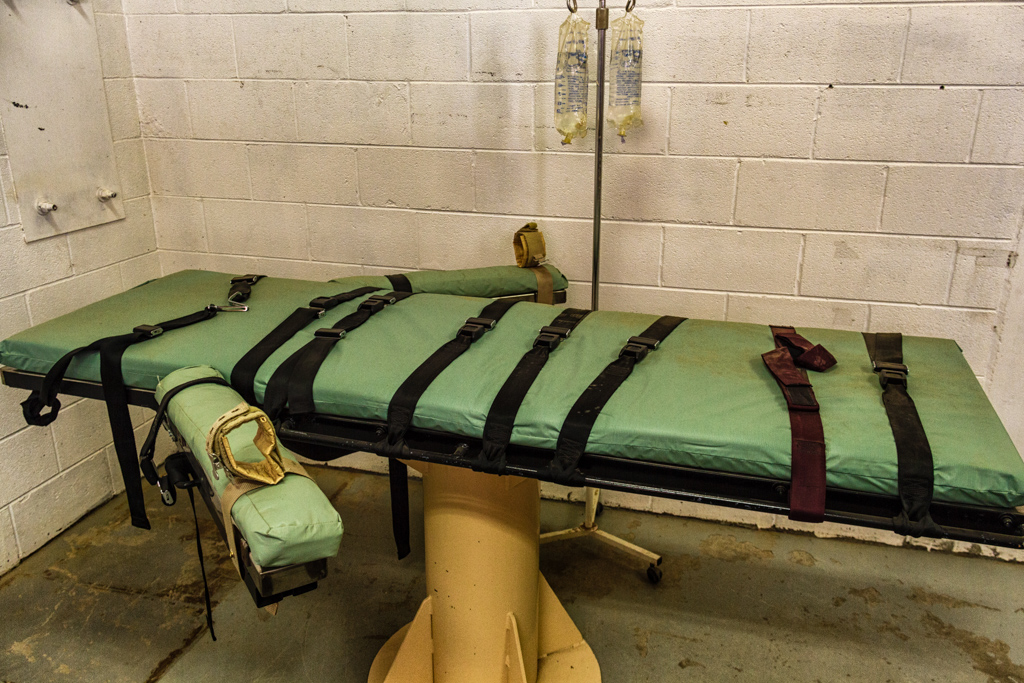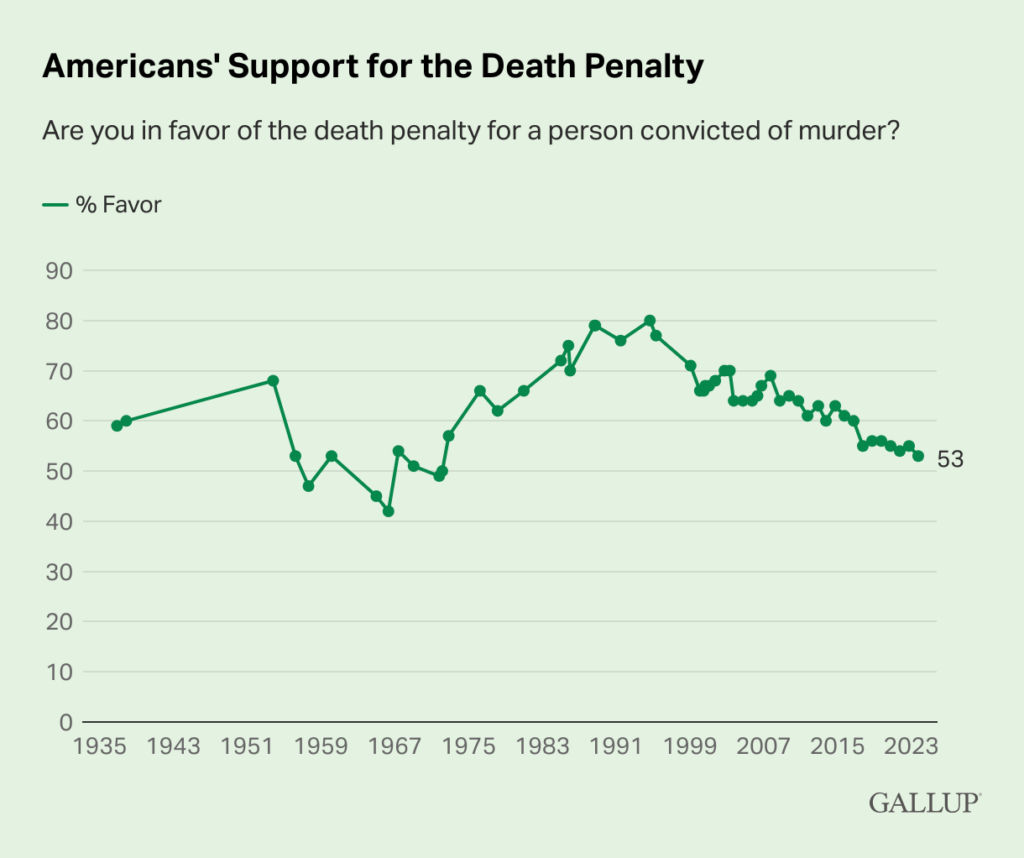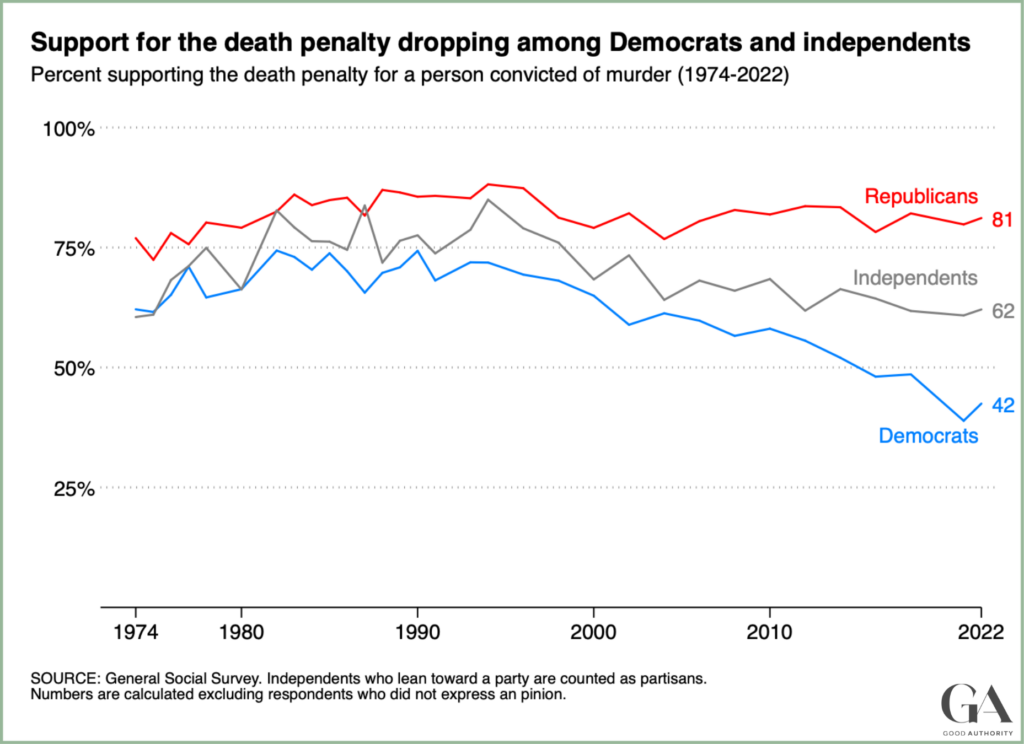
A lot of contemporary discourse about criminal justice focuses on the public’s perception that crime is a serious problem; the Republican Party’s advantage on the issue; and whether the issue poses a threat to Biden’s reelection.
So it seems worth pointing out a countervailing pattern: American support for the death penalty remains low. That is the conclusion of an October 2023 Gallup poll, which didn’t get much headline coverage. In that poll, only 53% of Americans favored “the death penalty for a person convicted of murder,” while 44% opposed it.
This is basically where opinion has been for the past 7 years, which represents a nearly 30-point decline from the high point of support in the early 1990s.

This is a remarkable change in opinion. It appears linked to two factors. First is the falling crime rate. In his book Incarceration Nation, the political scientist Peter Enns shows that the public’s punitiveness on crime is related to how much crime is occurring. And, despite the uptick in certain types of crime in 2020-21, the murder rate and violent crime rate decreased in 2022 and remain well below their 1990s peaks.
The second is the changing nature of media coverage about the death penalty. As documented by the political scientists Frank Baumgartner, Suzanna De Boef, and Amber Boydstun in The Decline of the Death Penalty and the Discovery of Innocence, media coverage of the death penalty shifted to focus on the problems in capital trials, the administration of the death penalty, other flaws in the system, and so on. This included coverage of cases where new evidence exonerated someone who had been sentenced to die. As the “innocence frame” became more prominent, media coverage became less favorable to the death penalty overall.
Based on these authors’ analysis of public opinion from 1976 to 2006, this shift in media coverage was also related to declining support for the death penalty, even after accounting for the murder rate. The apparent impact of the innocence frame is also visible in the increasing percentage of Americans who believe the death penalty is applied unfairly.
This decline in support for the death penalty isn’t uniform, however. It depends crucially on partisanship. Here, for example, is the trend in support for the death penalty in the General Social Survey, which asks a question similar to Gallup’s.

The decline in support is much larger among Democrats and independents than among Republicans.
Moreover, these trends have reduced racial divisions within the Democratic Party. The death penalty used to divide white Democrats from Black Democrats, but that’s no longer true. Today, equally sized majorities of both groups oppose the death penalty.

Black Americans who identify as independent or Republican are even more liberal than their white counterparts. For example, in the 2021-22 surveys, 68% of white independents supported the death penalty compared to 43% of Black independents. The small number of Black Republicans was much more opposed to the death penalty than white Republicans (61% vs. 82%).
It’s worth keeping this fact in mind, since much attention has been paid to whether white Democrats are to the left of Democrats in other racial groups on criminal justice issues. That may be true for some issues but it is not true for capital punishment.
This change in public opinion arguably has consequences for policy. Enns shows that trends in the public’s punitiveness are related to the incarceration rate. Similarly, Baumgartner and colleagues show that trends in support for the death penalty are related to the number of death sentences. Thus, the drop in support may help explain why the number of death sentences and executions in the U.S. has fallen.
Of course, the trends in public opinion haven’t somehow “resolved” the politics of the death penalty. Politicians like Donald Trump are calling for its expansion, after all. But it is striking that despite the recent (although temporary) increase in murder, there is no greater public appetite for executing convicted murderers.



